Multi-Scale Atmospheric Emissions, Circulation and Meteorological Drivers of Ozone Episodes in El Paso-Juárez Airshed
Abstract
:1. Introduction
2. Methodology
2.1. Site Description and Terrain
2.2. Observational Data and Modeling
2.2.1. Local Meteorological and Ozone Data
2.2.2. Vaisala Ceilometer Data
2.2.3. Radio Wind Profiler (RWP)
2.2.4. Hybrid Single Particle Lagrangian Integrated Trajectory Model (HYSPLIT)
2.2.5. Synoptic Scale Conditions
3. Results
3.1. Analysis of Inter-Annual Variations of Ozone Exceedances in EPJA
3.2. Impacts of PBL on High Ozone Events
3.3. Synoptic Effects on Ozone Concentrations
3.4. Mesoscale and Local Circulations during the Ozone Events
4. Discussion
Author Contributions
Funding
Institutional Review Board Statement
Informed Consent Statement
Data Availability Statement
Acknowledgments
Conflicts of Interest
Abbreviations
| AGL | above ground level |
| ARL | Air Research Laboratory |
| ASL | above sea level |
| CAMS | continuous ambient air monitoring station |
| CBLH | convective boundary layer height |
| EPJ | El Paso-Juarez |
| EPJA | El Paso-Juarez Airshed |
| HYSPLIT | Hybrid Single-Particle Lagrangian Integrated Trajectory |
| NOAA | National Oceanic and Atmospheric Administration |
| NWS | National Weather Service |
| PBL | Planetary Boundary Layer |
| PBLH | planetary boundary layer height |
| POE | Ports of Entry |
| ppbv | parts per billion per volume |
| RWP | Radio Wind Profiler |
| TCEQ | Texas Commission on Environmental Quality |
| UTEP | University of Texas at El Paso |
References
- Seinfeld, J.; Pandis, S. Atmospheric Chemistry and Physics, 2006; John Wiley & Sons: New Jersey, NJ, USA, 2006. [Google Scholar]
- Kaser, L.; Peron, A.; Graus, M.; Striednig, M.; Wohlfahrt, G.; Juráň, S.; Karl, T. Interannual Variability of BVOC Emissions in an Alpine City. Atmos. Chem. Phys. Discuss. 2021, 1–26. [Google Scholar] [CrossRef]
- Dominici, F.; Peng, R.D.; Bell, M.L.; Pham, L.; McDermott, A.; Zeger, S.L.; Samet, J.M. Fine Particulate Air Pollution and Hospital Admission for Cardiovascular and Respiratory Diseases. JAMA 2006, 295, 1127–1134. [Google Scholar] [CrossRef] [Green Version]
- Zanobetti, A.; Schwartz, J. The Effect of Particulate Air Pollution on Emergency Admissions for Myocardial Infarction: A Multicity Case-Crossover Analysis. Environ. Health Perspect. 2005, 113, 978–982. [Google Scholar] [CrossRef]
- Juráň, S.; Grace, J.; Urban, O. Temporal Changes in Ozone Concentrations and Their Impact on Vegetation. Atmosphere 2021, 12, 82. [Google Scholar] [CrossRef]
- Zora, J.E.; Sarnat, S.E.; Raysoni, A.U.; Johnson, B.A.; Li, W.-W.; Greenwald, R.; Holguin, F.; Stock, T.H.; Sarnat, J.A. Associations between Urban Air Pollution and Pediatric Asthma Control in El Paso, Texas. Sci. Total Environ. 2013, 448, 56–65. [Google Scholar] [CrossRef] [PubMed]
- Delfino, R.J.; Staimer, N.; Gillen, D.; Tjoa, T.; Sioutas, C.; Fung, K.; George, S.C.; Kleinman, M.T. Personal and Ambient Air Pollution Is Associated with Increased Exhaled Nitric Oxide in Children with Asthma. Environ. Health Perspect. 2006, 114, 1736–1743. [Google Scholar] [CrossRef] [PubMed] [Green Version]
- Karle, N.; Mahmud, S.; Fitzgerald, R.M.; Sakai, R.K.; Stockwell, W.R.; Demoz, B.B.; Morris, V.R. Analysis of Regional Meteorology during the Ozone Episodes in the El Paso—Juarez Airshed in the Summer of 2017. In Proceedings of the 99th American Meteorological Society Annual Meeting—AMS, Phoenix, AZ, USA, 6–10 January 2019. [Google Scholar]
- Karle, N.N.; Mahmud, S.; Sakai, R.K.; Fitzgerald, R.M.; Morris, V.R.; Stockwell, W.R. Investigation of the Successive Ozone Episodes in the El Paso–Juarez Region in the Summer of 2017. Atmosphere 2020, 11, 532. [Google Scholar] [CrossRef]
- MacDonald, C.P.; Roberts, P.T.; Main, H.H.; Dye, T.S.; Coe, D.L.; Yarbrough, J. The 1996 Paso Del Norte Ozone Study: Analysis of Meteorological and Air Quality Data That Influence Local Ozone Concentrations. Sci. Total Environ. 2001, 276, 93–109. [Google Scholar] [CrossRef]
- Brown, M.J.; Muller, C.; Wang, G.; Costigan, K. Meteorological Simulations of Boundary-Layer Structure during the 1996 Paso Del Norte Ozone Study. Sci. Total Environ. 2001, 276, 111–133. [Google Scholar] [CrossRef]
- Lu, D.; Reddy, R.S.; Fitzgerald, R.; Stockwell, W.R.; Williams, Q.L.; Tchounwou, P.B. Sensitivity Modeling Study for an Ozone Occurrence during the 1996 Paso Del Norte Ozone Campaign. Int. J. Environ. Res. Public. Health 2008, 5, 181–203. [Google Scholar] [CrossRef] [PubMed]
- Einfeld, W.; Church, H.W.; Yarbrough, J.W. Winter Season Air Pollution in El Paso-Ciudad Juarez; US Environmental Protection Agency, Region VI, Air, Pesticides & Toxics Division: Atlanta, GA, USA, 1995.
- Stockwell, W.R.; Fitzgerald, R.M.; Lu, D.; Perea, R. Differences in the Variability of Measured and Simulated Tropospheric Ozone Mixing Ratios over the Paso Del Norte Region. J. Atmos. Chem. 2013, 70, 91–104. [Google Scholar] [CrossRef]
- Walter, P.J.; Morris, G.A.; Flynn, J.; Kotsakis, A.; Spychala, M.D.; DuBois, D.W.; Wooten, M.; Trevino, K.; Fitzgerald, R.M. Analysis of Ozonesonde and Surface Measurements in San Antonio and El Paso during 2017 and 2019. In Proceedings of the American Geophysical Union, Fall Meeting 2019, San Francisco, CA, USA, 9–13 December 2019. [Google Scholar]
- Fujita, E.M. Hydrocarbon Source Apportionment for the 1996 Paso Del Norte Ozone Study. Sci. Total Environ. 2001, 276, 171–184. [Google Scholar] [CrossRef]
- Mahmud, S.; Karle, N.N.; Fitzgerald, R.M.; Lu, D.; Nalli, N.R.; Stockwell, W.R. Intercomparison of Sonde, WRF/CAMx and Satellite Sounder Profile Data for the Paso Del Norte Region. Aerosol Sci. Eng. 2020, 4, 277–292. [Google Scholar] [CrossRef]
- Karle, N.N. Studies of the Planetary Boundary Layer and Their Impact on Air Pollution in a Semi-Arid Region with Complex Terrain. Ph.D. Thesis, The University of Texas at El Paso, El Paso, TX, USA, 2021. [Google Scholar]
- Karle, N.N. Study of the Urban Heat Island and Its Effect on the Planetary Boundary Layer for the El Paso-Juarez Airshed. In Proceedings of the Americal Geophysical Union, New Orleans, LA, USA, 11–15 December 2017; p. A51A-2032. [Google Scholar] [CrossRef]
- Münkel, C. Mixing Height Determination with Lidar Ceilometers—Results from Helsinki Testbed. Meteorol. Z. 2007, 16, 451–459. [Google Scholar] [CrossRef]
- Schafer, K.; Emeis, S.M.; Rauch, A.; Munkel, C.; Vogt, S. Determination of Mixing Layer Heights from Ceilometer Data. In Proceedings of the Remote Sensing of Clouds and the Atmosphere IX—SPIE, Gran Canaria, Spain, 30 November 2004; Volume 5571, pp. 248–259. [Google Scholar]
- Ecklund, W.L.; Carter, D.A.; Balsley, B.B.; Currier, P.E.; Green, J.L.; Weber, B.L.; Gage, K.S. Field Tests of a Lower Tropospheric Wind Profiler. Radio Sci. 1990, 25, 899–906. [Google Scholar] [CrossRef]
- Stein, A.F.; Draxler, R.R.; Rolph, G.D.; Stunder, B.J.B.; Cohen, M.D.; Ngan, F. NOAA’s HYSPLIT Atmospheric Transport and Dispersion Modeling System. Bull. Am. Meteorol. Soc. 2015, 96, 2059–2077. [Google Scholar] [CrossRef]
- Fitzgerald, R.M.; Mahmud, S.; Karle, N.; Stockwell, W.R.; Sullivan, D.; Rogash, J. Analysis of Mesoscale and Synoptic Scale Meteorological Influences on Ozone; Project Report; Texas Commission on Environmental Quality: Austin, TX, USA, 2020.
- Comrie, A.C.; Yarnal, B. Relationships between Synoptic-Scale Atmospheric Circulation and Ozone Concentrations in Metropolitan Pittsburgh, Pennsylvania. Atmos. Environ. Part B Urban Atmos. 1992, 26, 301–312. [Google Scholar] [CrossRef]
- Trends in Fuel Production in the Permian Basin, 2011–2021. Available online: https://www.eia.gov/petroleum/drilling/pdf/permian.pdf (accessed on 1 November 2021).
- Pearson, R.; Fitzgerald, R. Application of a Wind Model for the El Paso-Juarez Airshed. J. Air Waste Manag. Assoc. 2001, 51, 669–680. [Google Scholar] [CrossRef]
- Solomon, P.; Cowling, E.; Hidy, G.; Furiness, C. Comparison of scientific findings from major ozone field studies in North America and Europe. Atmos. Environ. 2000, 34, 1885–1920. [Google Scholar] [CrossRef]
- Grineski, S.E.; Collins, T.W.; Chakraborty, J.; McDonald, Y.J. Environmental Health Injustice: Exposure to Air Toxics and Children’s Respiratory Hospital Admissions in El Paso, Texas. Prof. Geogr. 2013, 65, 31–46. [Google Scholar] [CrossRef]
- Fitzgerald, R.M.; Karle, N.N.; Lara, P.; Polanco, J.; Stockwell, W.R. Optical Measurements of Particulate Matter in the El Paso–Juárez Region: Natural Mineral Dust and Soot. In EM Magazine; Air & Waste Management Association: Pittsburgh, PA, USA, 2021. [Google Scholar]
- Sharifi, F.; Meitiv, A.; Shelton, J.; Xu, X.; Burris, M.; Vallamsundar, S.; Xu, Y.A. Regional Traffic Operation and Vehicle Emission Impact Assessment of Lane Management Policies. Res. Transp. Econ. 2021, 87, 101067. [Google Scholar] [CrossRef]
- Cambridge Systematics, Inc. “Economic Role of the El Paso Border Crossings, Technical Memorandum” for Texas Department of Transportation, February 2011. Available online: http://www.remi.com/wp-content/uploads/2017/12/105-Cambridge-Systematics-Economic-Role-of-the-El-Paso-Border-Crossings.pdf (accessed on 10 October 2021).
- Hallar, A.G.; Brown, S.S.; Crosman, E.; Barsanti, K.C.; Cappa, C.D.; Faloona, I.; Fast, J.; Holmes, H.A.; Horel, J.; Lin, J.; et al. Coupled Air Quality and Boundary-Layer Meteorology in Western U.S. Basins during Winter: Design and Rationale for a Comprehensive Study. Bull. Am. Meteorol. Soc. 2021, 102, E2012–E2033. [Google Scholar] [CrossRef]
- Karle, N.; Mahmud, S.; Fitzgerald, R.; Estes, M.; Walter, P.; Morris, G. Analysis of Boundary Layer Heights Using Ceilometer and Models in the El Paso-Juarez Airshed. In Proceedings of the 101st American Meteorological Society Annual Meeting, Online, 10–15 January 2021. [Google Scholar]
- Stockwell, W.R.; Lawson, C.V.; Saunders, E.; Goliff, W.S. A Review of Tropospheric Atmospheric Chemistry and Gas-Phase Chemical Mechanisms for Air Quality Modeling. Atmosphere 2012, 3, 1–32. [Google Scholar] [CrossRef] [Green Version]
- Donner, L.J.; Phillips, V.T. Boundary Layer Control on Convective Available Potential Energy: Implications for Cumulus Parameterization. J. Geophys. Res. Atmos. 2003, 108, 4701. [Google Scholar] [CrossRef] [Green Version]
- Athanassiadis, G.A.; Rao, S.T.; Ku, J.-Y.; Clark, R.D. Boundary Layer Evolution and Its Influence on Ground-Level Ozone Concentrations. Environ. Fluid Mech. 2002, 2, 339–357. [Google Scholar] [CrossRef]
- Gross, G.; Wippermann, F. Channeling and countercurrent in the upper Rhine valley: Numeric simulations. J. Clim. Appl. Meteol. 1987, 26, 1239–1304. [Google Scholar] [CrossRef] [Green Version]
- Whiteman, C.D.; Doran, J.C. The relationship between overlying synoptic-scale flows and winds within a Valley. J. Appl. Meteol. 1993, 32, 1669–1682. [Google Scholar] [CrossRef] [Green Version]
- Webber, R.O.; Kaufmann, P. Relationship of synoptic winds and complex terrain flows during MISTRAL field experiments. J. Appl. Meteol. 1998, 37, 37–1468. [Google Scholar] [CrossRef]
- Sakai, R.K.; Fitzjarrald, D.R.; Walcek, C.; Czikowsky, M.J.; Freedman, J.M. Wind Channeling in the Hudson Valley, NY. In Proceedings of the American Meteorological Society Annual Meeting 2006, San Diego, CA, USA, 21–25 May 2006. [Google Scholar]
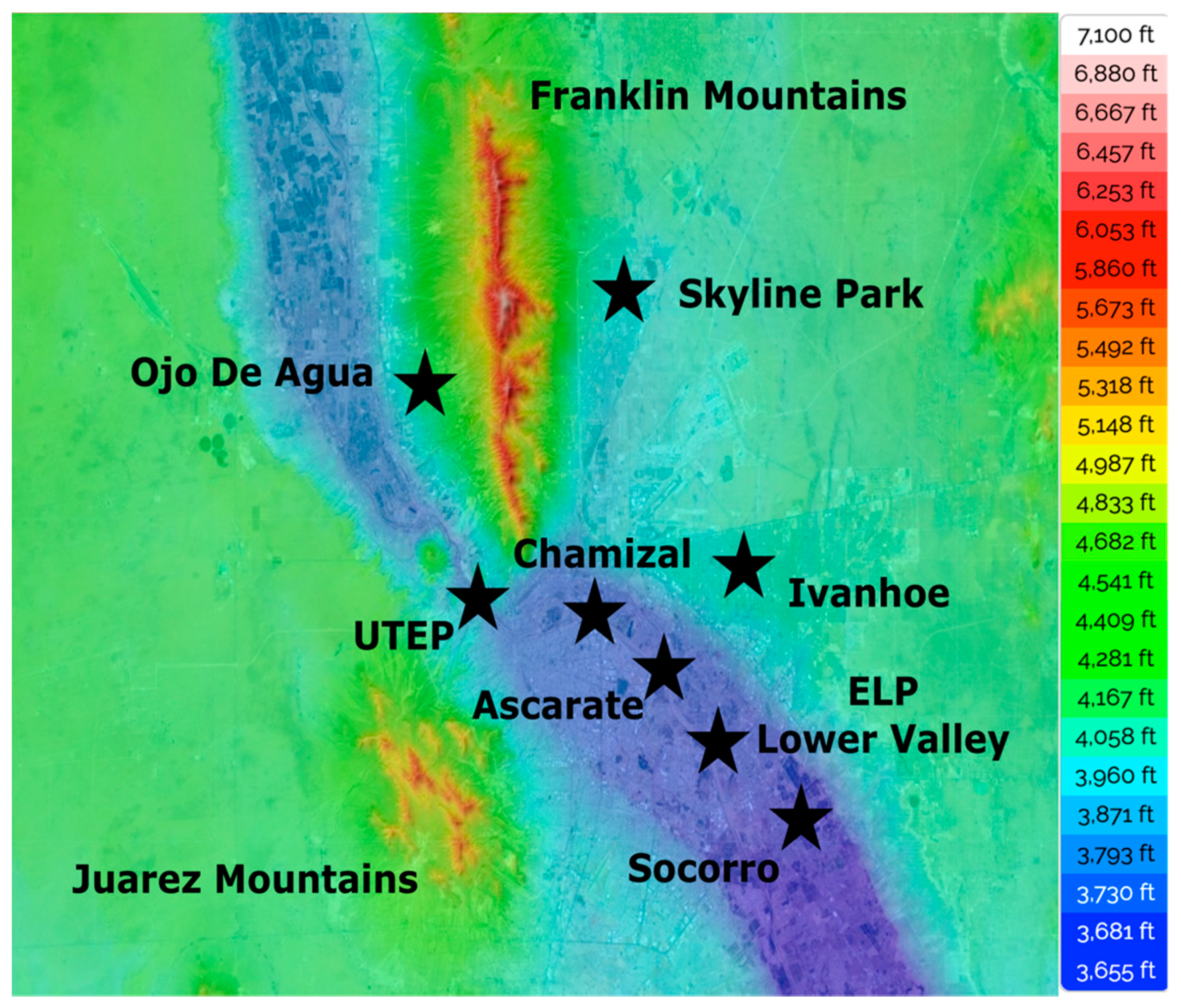




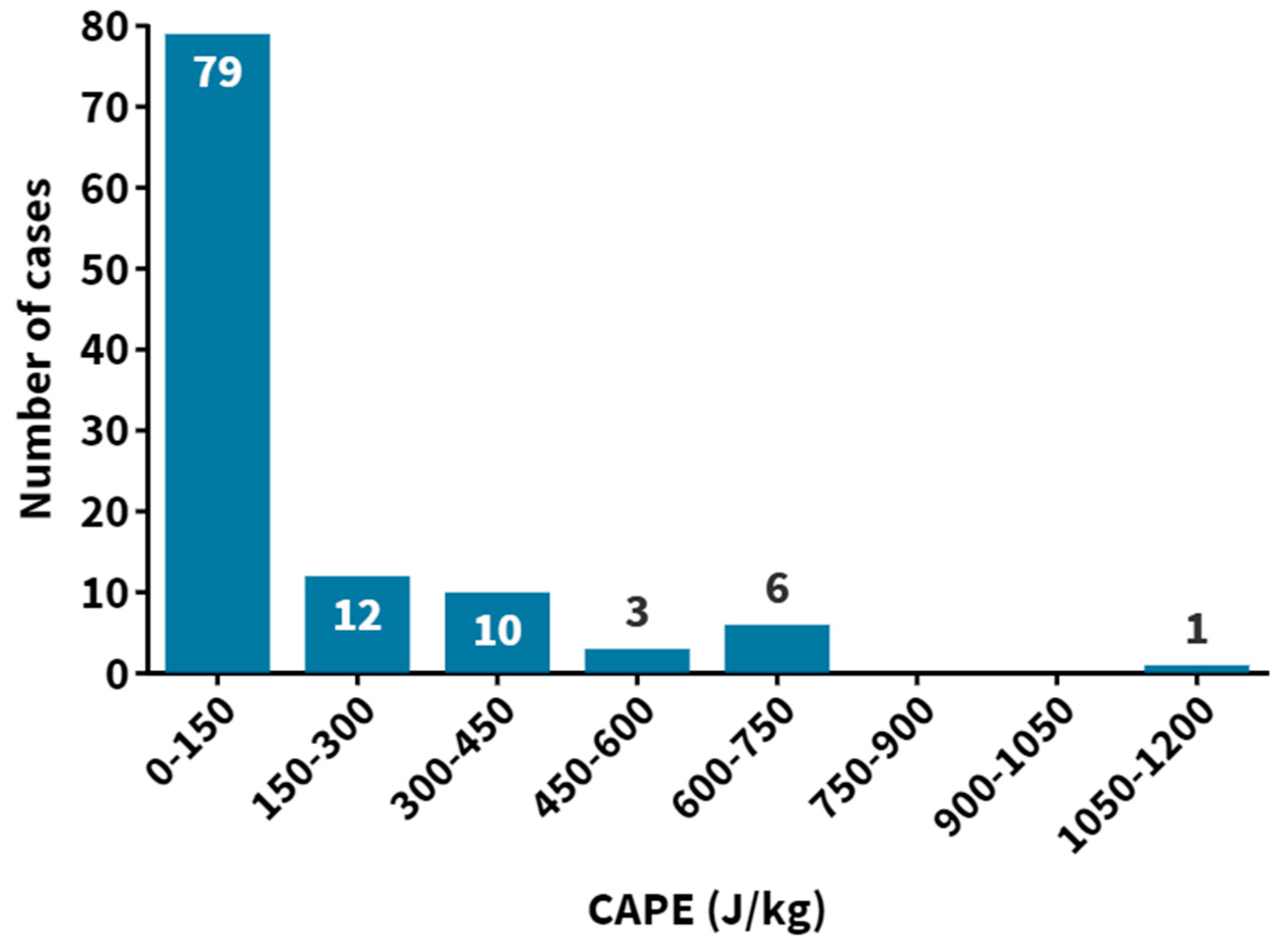
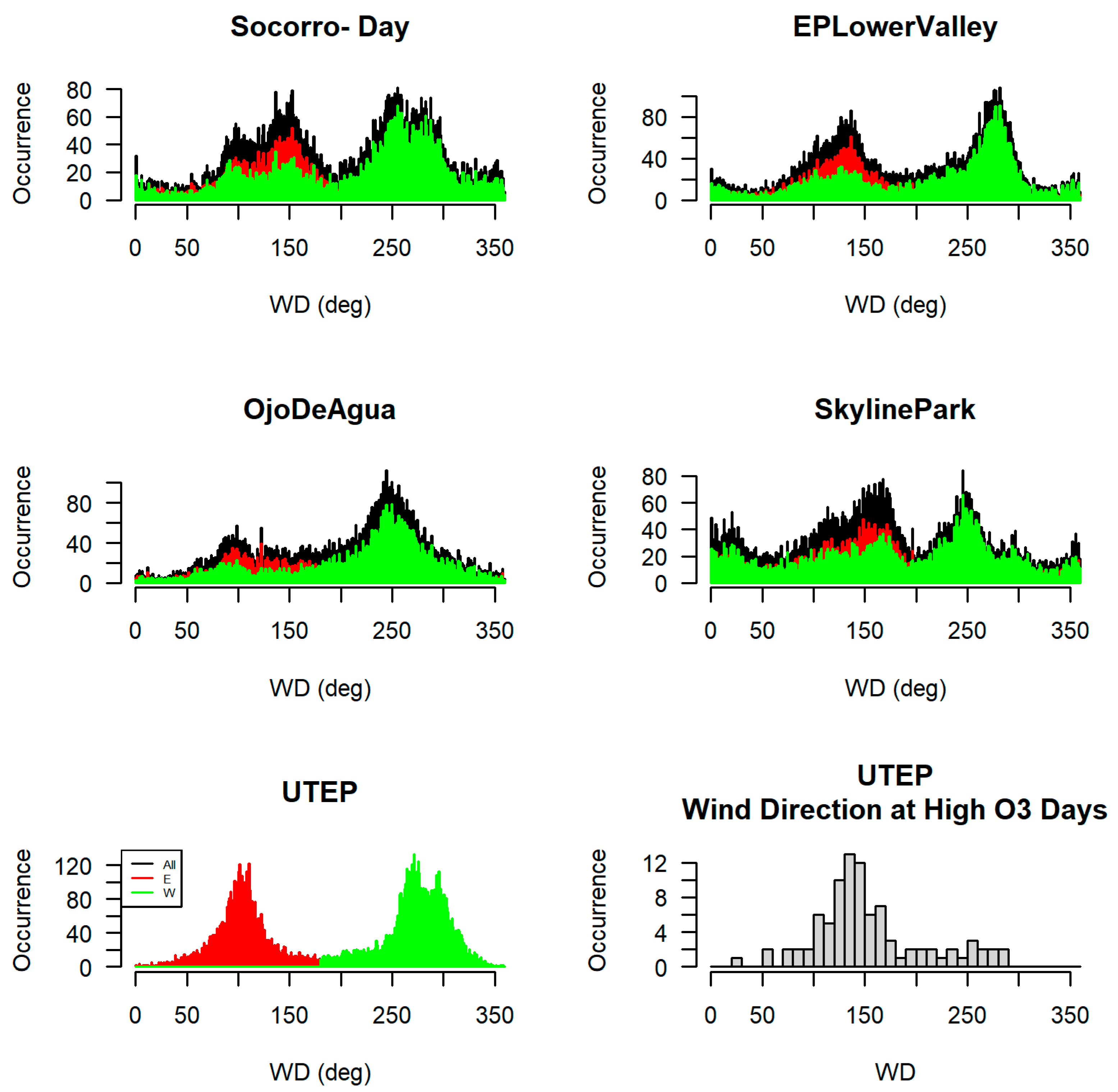
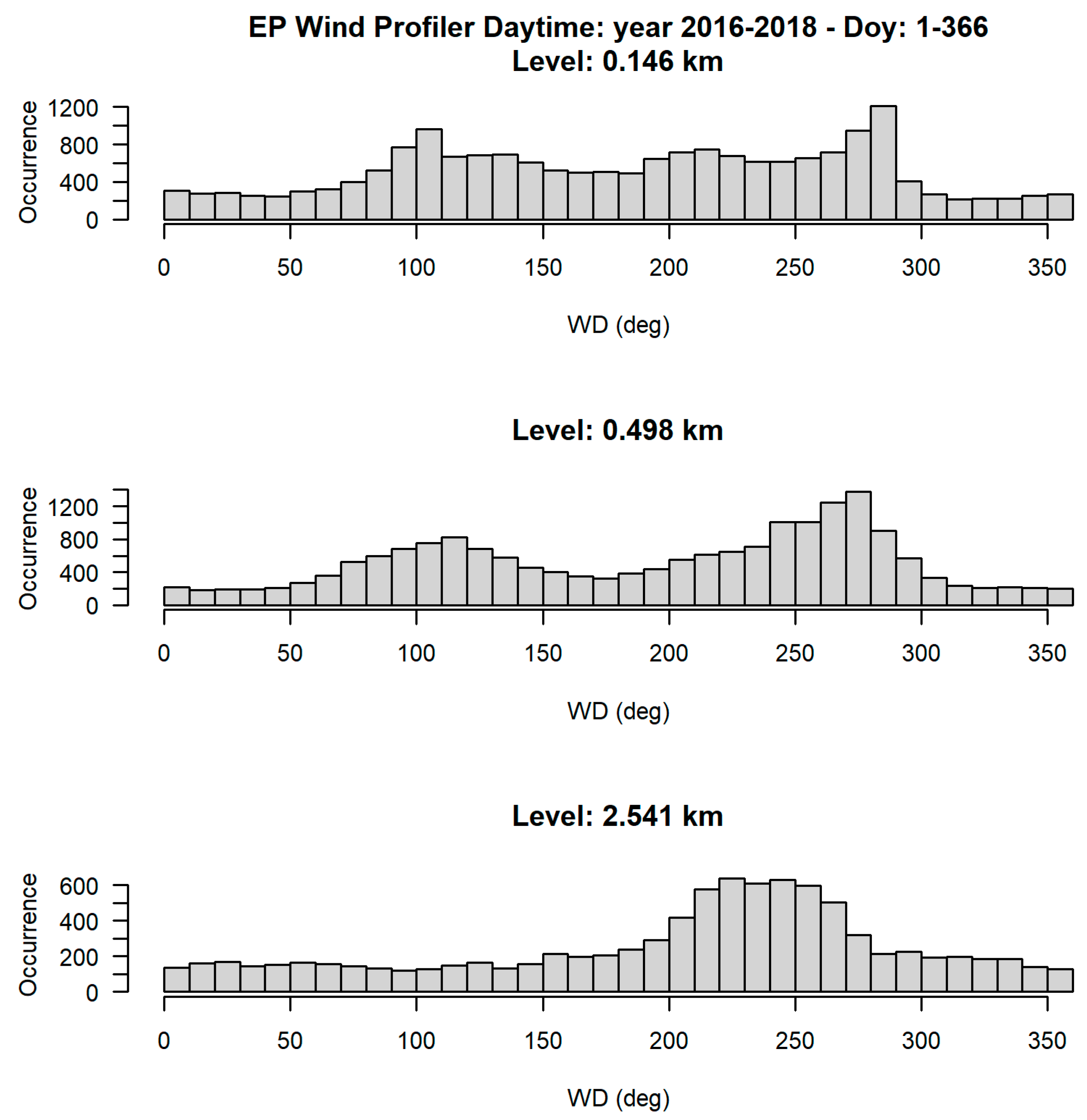
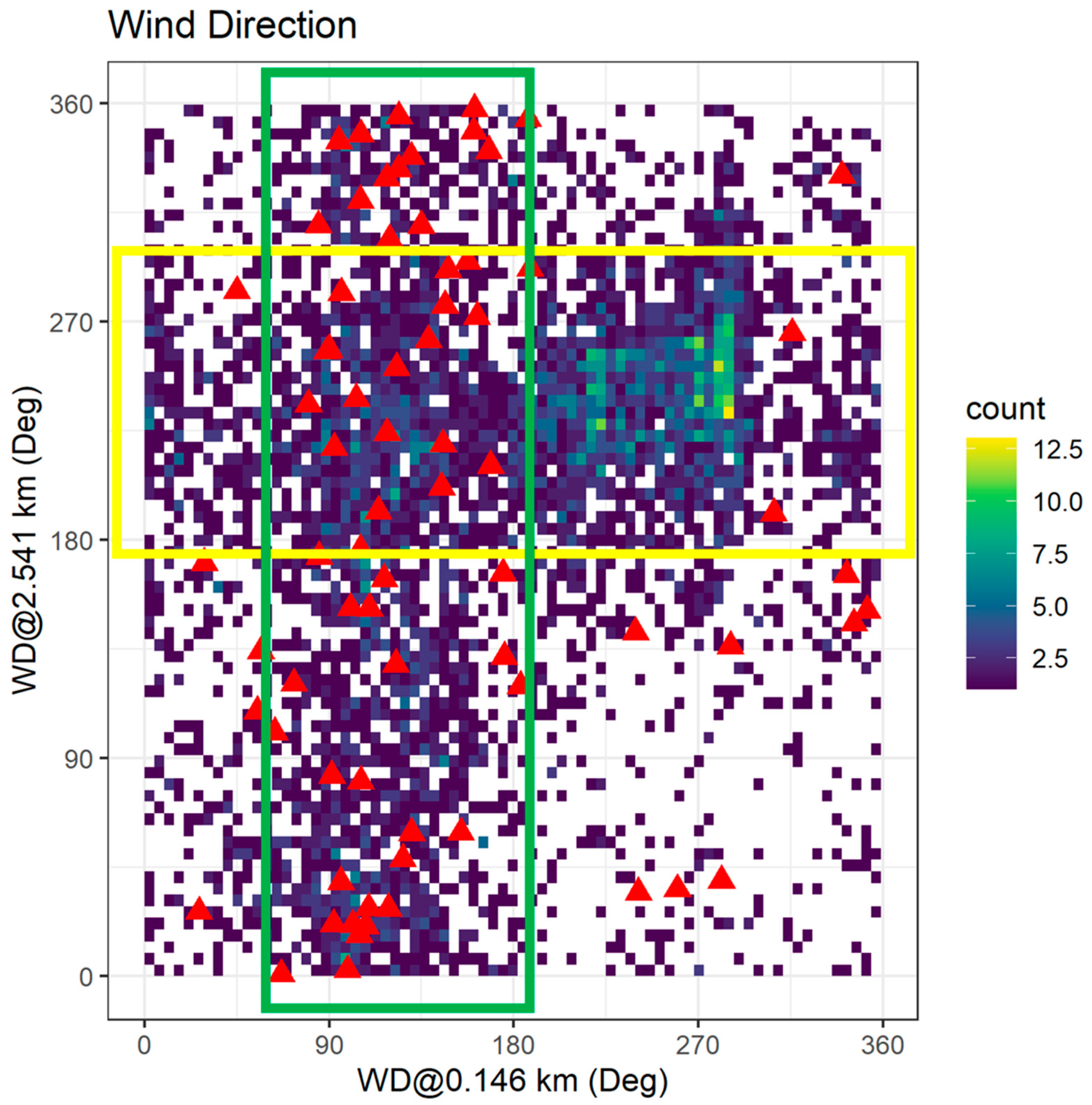
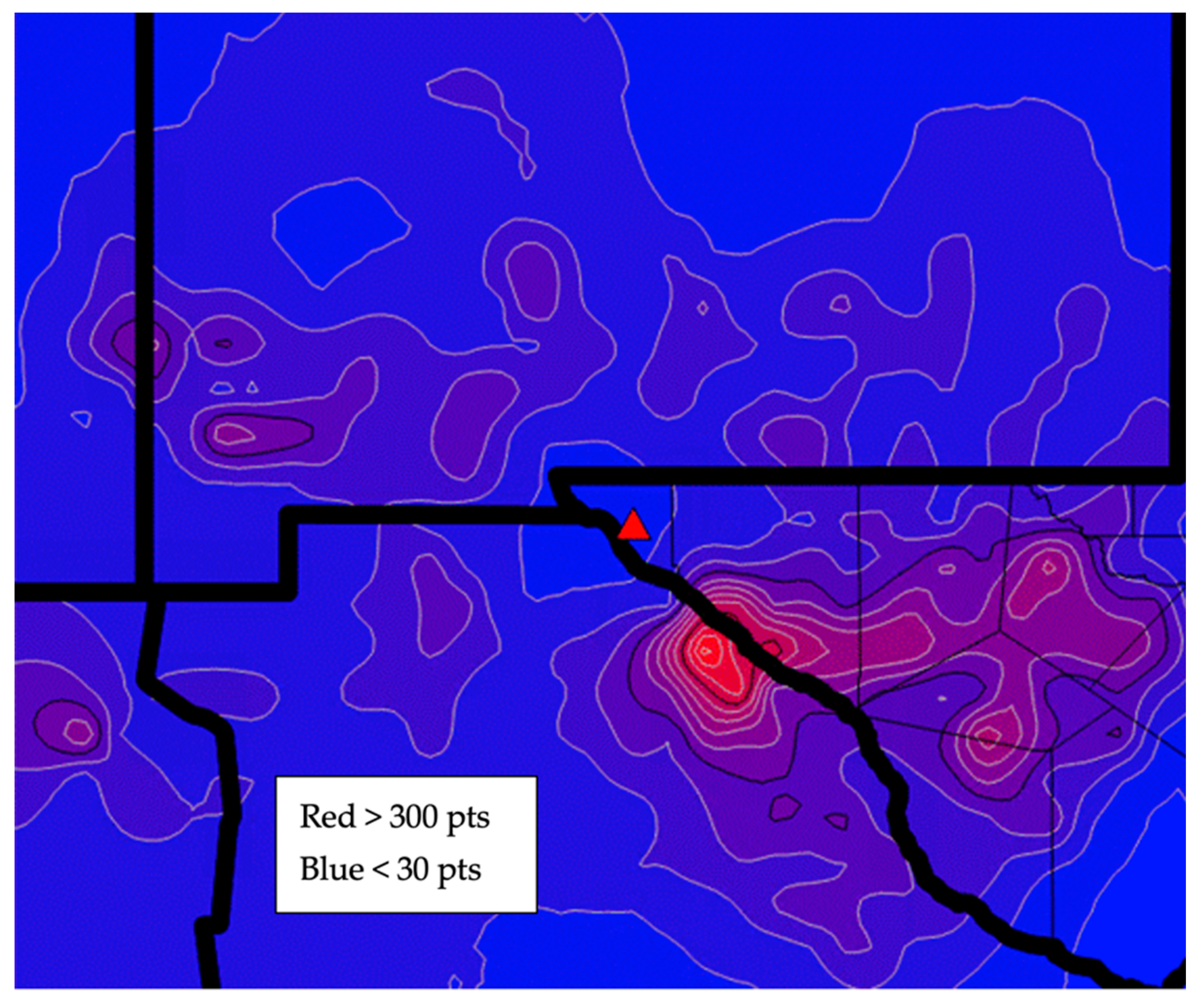
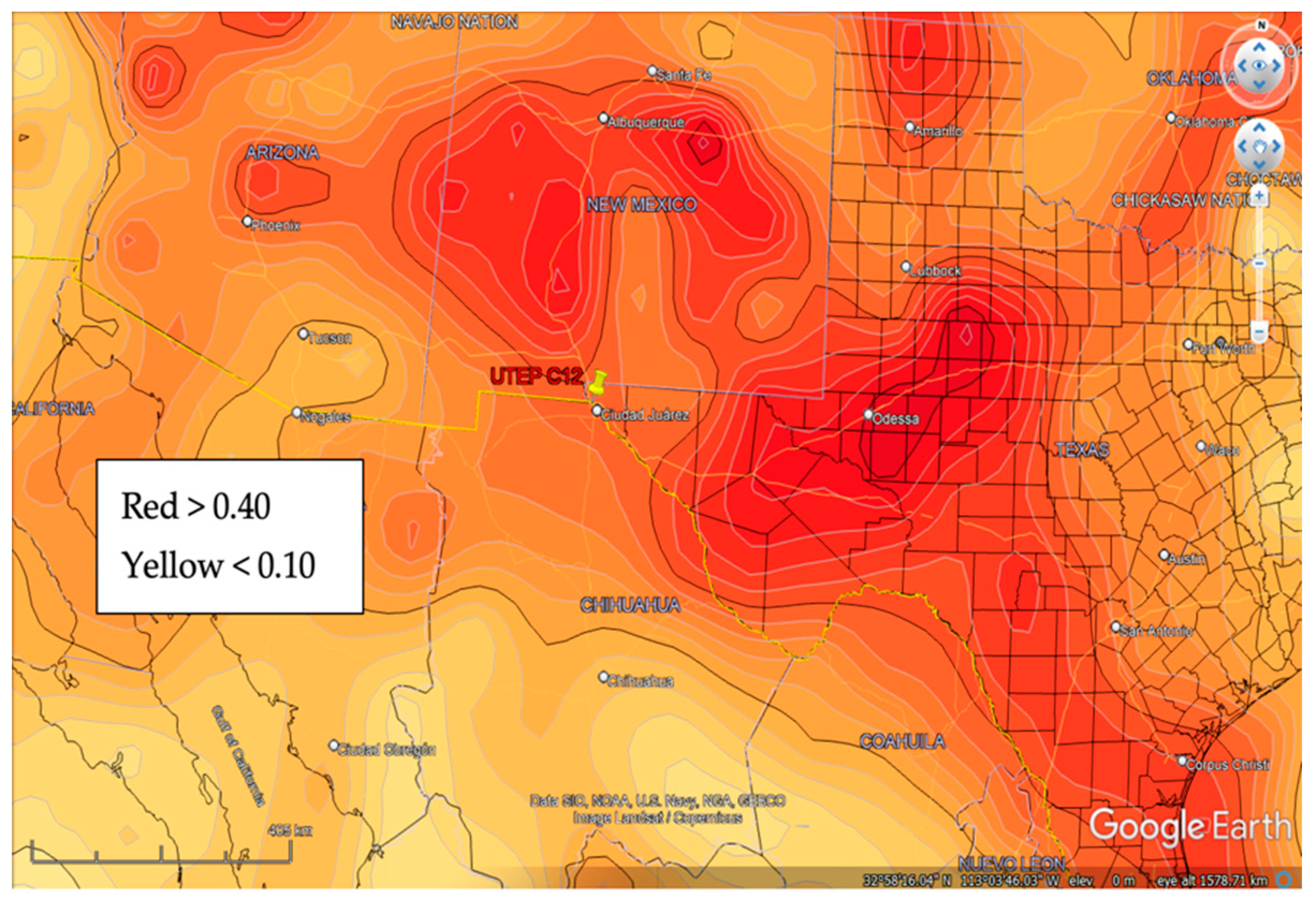
| Day and Year (HO3) | Daytime Max. PBLH ± 250 m | Day and Year (LO3) | Daytime Max. PBLH ± 250 m |
|---|---|---|---|
| 17 June 2015 | 1700 | 15 May 2015 | 3000 |
| 21 June 2015 | 1800 | 18 May 2015 | 2500 |
| 10 August 2015 | 1600 | 5 June 2015 | 2980 |
| 6 June 2016 | 1700 | 1 May 2016 | 2850 |
| 23 June 2016 | 2000 | 16 May 2016 | 3500 |
| 16 July 2016 | 2000 | 13 June 2016 | 3300 |
| 8 August 2016 | 2500 | 29 June 2016 | 3010 |
| 4 June 2017 | 1600 | 25 May 2017 | 3300 |
| 5 June 2017 | 1700 | 11 June 2017 | 2900 |
| 6 June 2017 | 3200 | 12 June 2017 | 2800 |
| 7 June 2017 | 2980 | 13 June 2017 | 3500 |
| 28 July 2017 | 2800 | 11 May 2018 | 2950 |
| 12 September 2017 | 2200 | 12 May 2018 | 2500 |
| 04 June 2018 | 2600 | 13 May 2018 | 2700 |
| 15 July 2019 | 1600 | 14 May 2018 | 2000 |
| 26 July 2019 | 3500 | 7 May 2019 | 3500 |
| 27 July 2019 | 1400 | 8 May 2019 | 3100 |
| 7 August 2019 | 1600 | 10 May 2019 | 2500 |
| 10 August 2019 | 1600 | 11 May 2019 | 2950 |
| 15 August 2019 | 1500 | 17 May 2019 | 3650 |
Publisher’s Note: MDPI stays neutral with regard to jurisdictional claims in published maps and institutional affiliations. |
© 2021 by the authors. Licensee MDPI, Basel, Switzerland. This article is an open access article distributed under the terms and conditions of the Creative Commons Attribution (CC BY) license (https://creativecommons.org/licenses/by/4.0/).
Share and Cite
Karle, N.N.; Fitzgerald, R.M.; Sakai, R.K.; Sullivan, D.W.; Stockwell, W.R. Multi-Scale Atmospheric Emissions, Circulation and Meteorological Drivers of Ozone Episodes in El Paso-Juárez Airshed. Atmosphere 2021, 12, 1575. https://doi.org/10.3390/atmos12121575
Karle NN, Fitzgerald RM, Sakai RK, Sullivan DW, Stockwell WR. Multi-Scale Atmospheric Emissions, Circulation and Meteorological Drivers of Ozone Episodes in El Paso-Juárez Airshed. Atmosphere. 2021; 12(12):1575. https://doi.org/10.3390/atmos12121575
Chicago/Turabian StyleKarle, Nakul N., Rosa M. Fitzgerald, Ricardo K. Sakai, David W. Sullivan, and William R. Stockwell. 2021. "Multi-Scale Atmospheric Emissions, Circulation and Meteorological Drivers of Ozone Episodes in El Paso-Juárez Airshed" Atmosphere 12, no. 12: 1575. https://doi.org/10.3390/atmos12121575
APA StyleKarle, N. N., Fitzgerald, R. M., Sakai, R. K., Sullivan, D. W., & Stockwell, W. R. (2021). Multi-Scale Atmospheric Emissions, Circulation and Meteorological Drivers of Ozone Episodes in El Paso-Juárez Airshed. Atmosphere, 12(12), 1575. https://doi.org/10.3390/atmos12121575









